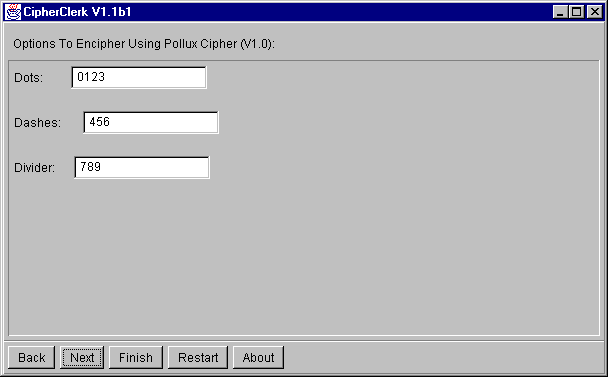Morse Code Based Ciphers
Pollux
The plain text is converted into morse code and the symbols of this code
are replaced by literals of your choice. You must enter the literals to
replace dots, dashes and dividers. No literal may appear as replacement
for more than once. CipherClerk's Applet chooses among the entered symbols at random.

Example: SOS SOS (= ...x---x...xx...x---x...x) may result in
00185 64810 17722 38564 90117. Note that word spacings are denoted
by two dividers and thus conserved.
Morbit
As before, the plain text is converted into morse code. A nine letter keyword
is required:

A numeric key is derived and used to encode the nine possible pairs
consisting of dashes, dots, and dividers. For the key word USER GUIDE
we obtain (* = dot, - = dash, x = divider):
| Key Word: |
U |
S |
E |
R |
G |
U |
I |
D |
E |
| Numeric Key: |
8 |
7 |
2 |
6 |
4 |
9 |
5 |
1 |
3 |
| 1st Symbol: |
* |
* |
* |
- |
- |
- |
x |
x |
x |
| 2nd Symbol: |
* |
- |
x |
* |
- |
x |
* |
- |
x |
Using this, SOS SOS results in 82498 25814 585.
Fractionated Morse
As before, the plain text is converted into morse code. Using a key word
and a mixing scheme a mixed 26 letter
alphabet is generated. The morse code is read in groups of three symbols
and each group is represented by a letter. (There are 3*3*3 = 27 possible
combinations, but three consecutive dividers are not allowed)

For the setup shown above, we obtain:
| E |
N |
T |
R |
H |
K |
Y |
A |
B |
C |
D |
F |
G |
I |
J |
L |
M |
O |
P |
Q |
S |
U |
V |
W |
X |
Z |
| * |
* |
* |
* |
* |
* |
* |
* |
* |
- |
- |
- |
- |
- |
- |
- |
- |
- |
x |
x |
x |
x |
x |
x |
x |
x |
| * |
* |
* |
- |
- |
- |
x |
x |
x |
* |
* |
* |
- |
- |
- |
x |
x |
x |
* |
* |
* |
- |
- |
- |
x |
x |
| * |
- |
x |
* |
- |
x |
* |
- |
x |
* |
- |
x |
* |
- |
x |
* |
- |
x |
* |
- |
x |
* |
- |
x |
* |
- |
Using this, SOS SOS yields EVLTP AJEX.
To proceed, you may